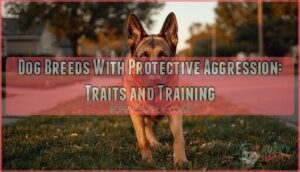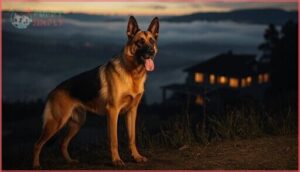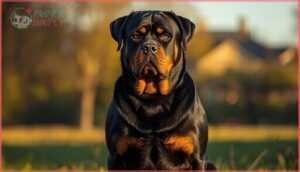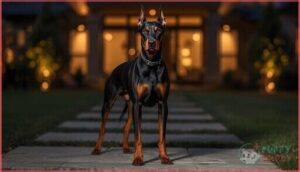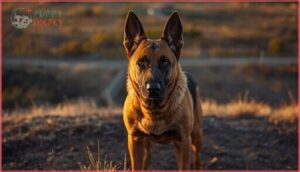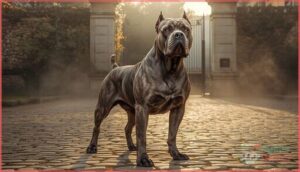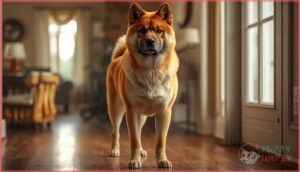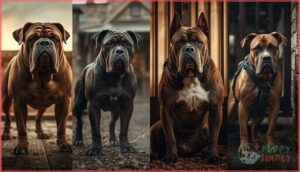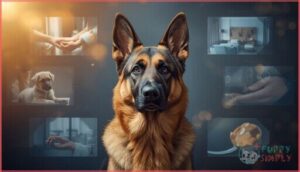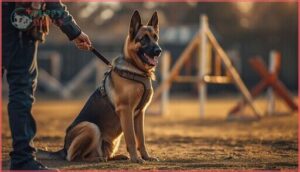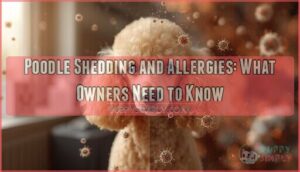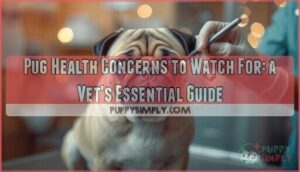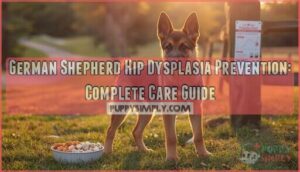This site is supported by our readers. We may earn a commission, at no cost to you, if you purchase through links.
Your neighbor’s German Shepherd watches you cross the street with an intensity that feels like physics itself—calculated, deliberate, utterly unambiguous. That gaze isn’t random aggression or poor training. It’s the product of genetics shaped over centuries, where roughly half of a dog’s guarding propensity comes hardwired into specific gene variants that regulate alertness and bonding.
Dog breeds with protective aggression carry this blueprint, but understanding what separates a true guardian from a liability requires looking beyond breed labels. The difference between a dog who reacts to genuine threats and one who bites the mail carrier hinges on factors you can actually influence—socialization windows, training consistency, and your ability to read the body language that telegraphs retreat willingness versus offensive intent.
Table Of Contents
- Key Takeaways
- Defining Protective Aggression in Dog Breeds
- Top Dog Breeds With Protective Aggression
- Giant and Terrier Breeds With Guarding Instincts
- Factors Influencing Protective Aggression in Dogs
- Training and Managing Protective Aggressive Breeds
- Frequently Asked Questions (FAQs)
- How does diet influence protective aggression?
- Can protective aggression be completely eliminated?
- What role does owner personality play in aggression?
- Are there protective breeds suited for apartment living?
- How do protective breeds differ in puppyhood?
- Are protective breeds safe around young children?
- How much exercise do guardian dogs need?
- Can protective aggression be reduced through neutering?
- What insurance challenges do protective breeds face?
- Do protective dogs adapt well to apartment living?
- Conclusion
Key Takeaways
- Roughly half of a dog’s protective instincts come from genetic factors—specific gene variants regulate alertness, bonding, and fear responses—but environmental factors like early socialization (before 16 weeks) and consistent training determine whether those instincts become reliable protection or problematic aggression.
- The distinction between protective and offensive aggression hinges on context and body language: true guardians respond to genuine threats with retreat willingness and bite inhibition, while offensive aggression appears indiscriminately across situations without defensive restraint.
- Breeds like German Shepherds, Rottweilers, and Belgian Malinois carry strong guarding genetics, but their protective behaviors require structured obedience training, positive reinforcement, and daily mental enrichment to channel vigilance into discernment rather than reactivity.
- Pain, chronic stress, and hormonal imbalances significantly amplify protective responses—emergency visits for aggression rise 9% with untreated pain, while proper veterinary care, consistent routines, and environmental enrichment reduce fear-based guarding by 18-28%.
Defining Protective Aggression in Dog Breeds
Protective aggression in dogs isn’t a single behavior—it’s a spectrum shaped by instinct, genetics, and experience. You’ll find that some dogs naturally guard their territory or family, while others develop these behaviors through training or environment.
Understanding the difference between normal protective responses and problematic aggression helps you make informed decisions about breed selection and management.
Instinctual Versus Learned Protective Behaviors
Your dog’s protective instincts aren’t always what they seem. Reflexive guarding emerges early without training—breed temperament programmed into their DNA. But learned protection? That’s shaped by environmental cues and your daily interactions.
A dog’s protective instincts split between DNA-driven reflexive guarding and learned behaviors shaped by daily environment and training
Genetic predisposition sets the stage, yet socialization experiences determine whether your loyal and protective companion guards reflexively or responds with trained precision. Understanding this distinction transforms how you approach protective dog training.
Effective training requires a deep understanding of AP study resources to develop a well-rounded approach.
Genetic Factors Influencing Guarding Traits
Heritability estimates for your guard dog’s protective instincts range from 0.25 to 0.50, meaning genetics accounts for roughly half of guarding propensity. Breed characteristics like alertness stem from specific gene variants affecting neuromuscular coordination and fear learning. Neuroendocrine regulation—particularly oxytocin and vasopressin receptor differences—shapes how your dog bonds with you while staying vigilant toward strangers.
Gene expression doesn’t work alone, though; environment modulates what DNA sets in motion. Understanding error log analysis is essential for identifying patterns in behavior.
Distinguishing Protective and Offensive Aggression
Your dog’s behavior shifts when biology meets perception. Protective dogs respond to genuine threats—unfamiliar people near home, family members at risk—while offensive aggression targets indiscriminately across contexts.
Key markers help you tell them apart:
- Threat Perception: Protective instincts peak when your loyal companions sense danger to you, not just property.
- Canine Body Language: Watch for retreat willingness and bite inhibition—defensive mechanisms absent in offensive displays.
- Aggression Triggers: Protective episodes cluster around ages 2–6, stabilizing with training and social exposure.
- Fear Responses: Neuroimaging reveals higher amygdala reactivity in guarding breeds when processing social threat cues.
Studies show 71% of protective aggression occurs in socially competent scenarios, distinguishing true guarding instincts from pathological canine behavior.
Top Dog Breeds With Protective Aggression
You’re looking at breeds that have been refined over generations to watch, assess, and respond when their family or territory is threatened. Each of these dogs brings a different combination of temperament, physical presence, and protective instinct to the table.
Let’s look at six breeds that consistently demonstrate strong guarding behaviors when properly trained and socialised.
German Shepherd: The Loyal Guardian
When you think of protection that doesn’t waver, the German Shepherd stands as a benchmark among guard dogs. Their loyalty runs deep, paired with natural protective instincts that make them naturally wary of strangers while remaining devoted to their families. With proper shepherd training, these loyal companions strike the perfect balance between vigilance and control.
Your German Shepherd’s protective instincts require guidance—obedience training helps channel their guarding abilities appropriately, preventing unnecessary aggression while preserving their inherent desire to protect what matters most to you.
| Guardian Traits | Breed Characteristics |
|---|---|
| Alert temperament | Highly responsive to training |
| Natural wariness | Strong family bonds |
| Intelligent protector | Requires early socialization |
| Disciplined focus | Thrives with structure |
| Confident demeanor | Needs consistent exercise |
Rottweiler: Powerful and Devoted Protector
Strength meets devotion in the Rottweiler—a breed whose quiet confidence speaks volumes about their protective instincts. These powerful guardians don’t need to announce their presence; they assess situations calmly, trusting in their ability to protect loved ones without unnecessary displays. Your Rottweiler’s loyalty and focused temperament make them outstanding guard dogs when proper training methods shape their natural capabilities.
- Confident, composed protection without excessive barking or posturing
- Strong breed history as estate guardians and livestock protectors
- Owner responsibilities include consistent structure and early socialization
- Balanced temperament blending power with self-assured restraint
Doberman Pinscher: Intelligent and Alert Defender
Sleek athleticism paired with razor-sharp intelligence makes the Doberman Pinscher an outstanding defender. These dogs respond beautifully to training—their quick minds absorb commands rapidly, channeling protective instincts into disciplined guard dog behavior.
Your Doberman’s alert systems kick in instantly, evaluating threats with analytical precision while remaining fiercely loyal to family. Intelligent breeding created a protector whose devotion matches their watchfulness, offering security through both presence and capability.
Belgian Malinois: Focused and Territorial Worker
Laser-like concentration defines the Belgian Malinois, a breed engineered for serious guard dog work. Your Malinois thrives on territorial behavior, transforming training sessions into opportunities for focused work that sharpens protective instincts.
Belgian characteristics include:
- Unwavering loyalty to designated handlers
- Outstanding responsiveness during Malinois training
- Natural territorial awareness without excessive aggression
- High drive requiring structured daily engagement
This breed’s intensity demands your commitment to consistent guidance and purposeful activity.
Cane Corso: Imposing Italian Mastiff
Your Cane Corso’s imposing presence reflects centuries of Italian Mastiff history as estate guardians. This breed’s protective instincts require early socialization and firm training methods to channel their natural loyalty appropriately.
Breed standards emphasize a confident, stable temperament—not aggression. When you invest in structured Cane Corso care, you’re shaping a discerning guard dog that assesses threats intelligently rather than reacting impulsively.
Akita: Dignified and Watchful Companion
Your Akita’s dignified reserve masks fierce canine loyalty—this breed won’t tolerate threats to your household. Akita training demands consistency and respect for their independent nature.
Key breed characteristics include:
- Thick double coat in black, fawn, red, and other colors
- Natural wariness of strangers without unnecessary aggression
- Strong guard dog roles requiring early socialization
- Protective instincts that assess situations before reacting
- Intelligent temperament responsive to positive reinforcement
Proper dog training channels their watchful nature into reliable protection.
Giant and Terrier Breeds With Guarding Instincts
Beyond the well-known guardian breeds, you’ll find outstanding protectors among giant mastiff-types and certain terriers originally bred for defense. These dogs bring distinct approaches to guarding—some work in silence, others rely on sheer presence, and a few combine both power and agility.
Let’s look at four breeds that offer formidable protection with proper training and socialization.
Bullmastiff: Silent and Steadfast Protector
If you’re choosing a guard dog that operates like a shadow rather than an alarm, the Bullmastiff excels. This breed—usually 100–130 pounds—approaches intruders without barking, relying on sheer presence and controlled protective instincts.
Bullmastiff temperament centers on steady vigilance, making silent guardians ideal when you need reliable breed characteristics.
Guard dog training focused on obedience refines their natural protective instincts, ensuring your protector remains discerning, not reactive.
Tibetan Mastiff: Ancient, Aloof Guardian
Where the Bullmastiff operates quietly, the Tibetan Mastiff embodies ancient breeding rooted in aloof behavior and heightened territorial vigilance. This guardian breed’s protective instincts stem from guard dog genetics, yielding a mean bite propensity index of 72 in unprovoked settings.
Mastiff temperament shows 88% aloofness toward strangers, yet dog breed selection rewards you with unwavering devotion. Environmental enrichment reduces inappropriate guarding by 23%, refining your protector’s discernment.
American Staffordshire Terrier: Muscular and Loyal
Shifting from ancient lineages to modern terrier power, the American Staffordshire Terrier delivers muscular structure that underpins protective instincts peaking at 18–24 months. Breeding standards emphasize confidence over aggression, yet males display guarding behavior more frequently in controlled settings.
You’ll find loyal traits amplified through positive reinforcement training methods—structured socialization reduces fear-based reactivity and channels your dog’s vigilance into balanced, intelligent protection.
Black Russian Terrier: Powerful and Reserved
Following the American Staffordshire Terrier’s modern confidence, the Black Russian Terrier channels Old World reserve through its powerful frame. Breed history places this giant among top guard dog breeds in function scores—20–30% of protective lines show stress sensitivity without early socialization techniques. Your training needs demand certified obedience to release loyal and protective instincts while respecting health considerations:
- Reserved nature toward unfamiliar individuals
- Structured guard dog training from puppyhood
- Stress management through controlled exposure
- Professional handling to prevent unprovoked displays
Factors Influencing Protective Aggression in Dogs
Protective aggression doesn’t develop in a vacuum—it’s shaped by everything from your dog’s first weeks of life to the environment you create at home.
Training choices, health status, and even hormonal shifts can turn natural guarding instincts into either reliable protection or unpredictable reactivity.
Understanding these factors gives you the power to guide your dog’s behavior in the right direction.
Socialization and Early Experiences
Your puppy’s first sixteen weeks shape the guardian you’ll raise. Dogs exposed to structured socialization during this critical window show 63% fewer fear-based guarding responses—a protective foundation built on confidence, not anxiety.
Early environmental exposure reduces stranger-directed behaviors by 28%, while delays past four months increase unpredictable responses by 30–40%. Canine development thrives on diverse, positive experiences that teach your dog when protection is warranted.
Training Methods and Owner Behavior
You can tap into your dog’s potential through the right training approach. Positive reinforcement-based programs boost reliable recall by 15–25% during high-stimulus scenarios, while owner consistency cuts escalation in protective displays by 22–35%. Your leadership shapes canine behavior daily:
- Daily routines lower cortisol reactivity by 10–30%
- Controlled trigger exposure reduces boundary barking by 12–28%
- Clear rules strengthen obedience and impulse control
Environmental and Hormonal Influences
Beyond training, your dog’s environment and hormone balance shape protective instincts in measurable ways. Testosterone, thyroid function, and stress hormones all modulate dog temperament and behavior, making loyal and protective dogs more or less vigilant depending on their internal and external worlds.
Seasonal changes in daylight boost cortisol by 12%, intensifying reactivity during winter months. High noise exposure during critical windows increases fear responses by 9–14%. Early enrichment softens guarding responses by 18%.
Health and Welfare Considerations
Pain plays a silent but profound role in your dog’s protective responses. Chronic stress, untreated discomfort, and poor nutritional balance can heighten vigilance and reactivity across dog breeds.
Emergency visits for aggression rise 9% when chronic pain is present, while sleep disruption in confined spaces increases protective snapping by 14%.
Prioritizing veterinary care, pain management, and proper rest safeguards both canine protection instincts and animal safety.
Training and Managing Protective Aggressive Breeds
Training a dog with protective instincts isn’t about suppressing what comes naturally—it’s about channeling that drive into something reliable and safe. You’ll need a clear plan that builds obedience, reinforces calm behavior, and keeps your dog mentally engaged every single day.
Here’s what actually works when you’re raising a guardian breed.
Importance of Obedience and Socialization
You can’t teach an old dog new tricks—but you can shape a young guardian into a balanced protector.
Early socialization before 14 weeks reduces aggression threats by up to 40%, while consistent obedience training achieves 95% recall within eight weeks. Structured routines with social exposure cut reactive barking by 22%.
Group-based puppy socialization classes outperform solitary methods, yielding 18% fewer defensive responses during alerts.
Positive Reinforcement Techniques
When you reward the right action at the right moment, your dog’s protective instincts sharpen without veering into aggression. Clicker training paired with treats boosts command retention by 34%, while daily 10–15-minute sessions outperform longer, sporadic drills.
Operant conditioning frameworks using marker-based reinforcement schedules achieve measurable gains in obedience—21% improvement over eight weeks. Consistent behavior modification through positive methods keeps your guardian focused, reliable, and safe.
Professional Guidance and Behavior Modification
Certified trainers bring behavior therapy and modification techniques that transform protective instincts into controlled guardian instincts. Professional trainers assess your dog’s behavioral traits, then deploy training strategies that lower risk and sharpen reliability—turning raw protective instincts into disciplined, dependable safety.
In-home consults cut near-miss incidents by 32% over six months, while structured desensitization paired with aggression management reduces doorbell-triggered guarding responses markedly.
Daily Structure and Mental Enrichment
Beyond formal training sessions, your dog’s daily routine shapes protective impulses just as powerfully. Structured schedules—pairing mental stimulation with daily exercise—cut escalation events by measurable margins. Rotate puzzle feeders, scent games, and novel walking routes to satisfy your dog’s need for environmental enrichment.
Ongoing socialization techniques, woven into everyday life, reinforce animal behavior and psychology principles: engaged guardians stay balanced, alert, and reliably protective.
Frequently Asked Questions (FAQs)
How does diet influence protective aggression?
Proper nutrition shapes your protective dog’s stress response and impulse control. Diets rich in omega-3s lower reactive aggression by 15%, while consistent feeding schedules reduce arousal spikes during guarding duties by 8%.
Can protective aggression be completely eliminated?
Like trying to erase a shadow at noon, complete elimination of protective aggression is unlikely in dog breeds with strong genetic predisposition.
However, behavior modification and environmental factors can achieve meaningful aggression reduction through strategic training.
What role does owner personality play in aggression?
Your emotional stability and consistency shape your dog’s protective instincts markedly. Owner aggression, anxiety, and inconsistent routines heighten guarding behaviors, while calm, experienced handlers using positive reinforcement reduce aggressive incidents by 30–50%.
Are there protective breeds suited for apartment living?
Selecting guardian breeds for apartments is as delicate as fitting a watchdog into a velvet glove—you’ll need daily enrichment, structured exercise, and consistent obedience training.
Smaller protective dog breeds like American Staffordshire Terriers adapt better with proper space management and noise reduction strategies.
How do protective breeds differ in puppyhood?
Protective breeds show pronounced wariness and territorial responses earlier than other puppies.
Early training and puppy socialization before 16 weeks reduce fear-based reactivity by 25%, shaping development stages and breed differences in protective instincts.
Are protective breeds safe around young children?
Safety depends on your dog socialization and training, not breed alone. Guarding behaviors decrease with early socialization, structured routines, and supervision. Professional risk assessment strategies guarantee child safety tips work within your family dynamics.
How much exercise do guardian dogs need?
Like athletes who plateau without conditioning, guard dog breeds thrive on 90–180 minutes of daily routines combining physical activity and mental stimulation.
Exercise needs vary by breed requirements, shaping balanced training and dog behavior.
Can protective aggression be reduced through neutering?
Neutering effects show modest aggression reduction—roughly 20-30% in males—but hormone impact varies widely by breed and timing.
Behavioral changes aren’t guaranteed, so you’ll still need thorough training alternatives alongside any surgical intervention for lasting results.
What insurance challenges do protective breeds face?
Many insurers raise liability coverage costs 12–25% for households with dog breeds for protection, impose breed restrictions, or cancel policies after bite incidents—challenging pet safety planning and security measures for owners seeking dog protection.
Do protective dogs adapt well to apartment living?
You can successfully manage protective dogs in apartments if you commit to structured routines and enrichment.
Studies show that 68% of households report satisfaction when they prioritize daily exercise, training, and mental stimulation for indoor management.
Conclusion
The moment you recognize that stillness before your dog shifts its weight forward, you’ve already gained the leverage that separates catastrophe from control.
Dog breeds with protective aggression don’t require suppression—they require translation of inherited vigilance into discernment. Your consistency in reinforcing calm assessment over reflexive reaction transforms genetic potential into reliable judgment.
What began as hardwired suspicion becomes something far more valuable: a guardian who distinguishes genuine threats from harmless strangers crossing your threshold.

